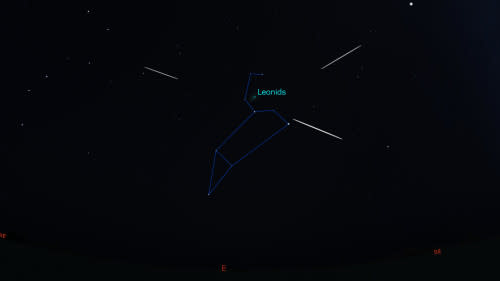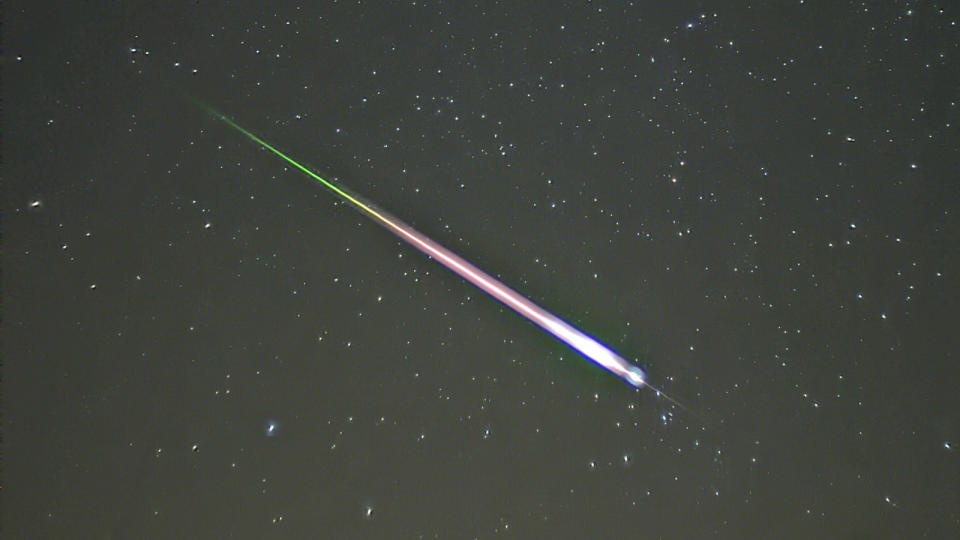Look up! Bright Leonid meteors may streak across the sky overnight tonight

Are there clear skies in your forecast early Tuesday morning? If so, head outside to somewhere dark and turn your eyes towards the stars. We could see a bright outburst from the Leonid meteor shower.
As Earth revolves around the Sun, our planet spends the month of November immersed in a broad stream of ice and dust left behind by a comet known as 55P/Tempel-Tuttle. First discovered in 1865, Comet Tempel-Tuttle crosses Earth's orbit once every 33 years. Right now, 25 years after its 1998 flyby, it is far out beyond the orbit of Saturn and slowly making its way back for another pass in 2031.
Throughout November, though, the tiny bits of debris left behind by the comet get swept up by Earth's atmosphere. There, they serve as a reminder of the comet's existence as they produce the annual Leonid Meteor Shower.

Leonid meteors appear to radiate outward from within the constellation Leo during the November 17-18 peak. Credit: Stellarium/Scott Sutherland
From November 3 to December 2, patient observers can spot at least a handful of fast, bright meteors streaking out of the constellation Leo each night. However, around November 17 each year, Earth sweeps through the densest part of the comet's stream. On that night, the Leonid meteor shower reaches its peak, producing between 10 and 15 meteors every hour.
That's not as strong as the August Perseids or the December Geminids. Still, a bright meteor flashing by every four to five minutes, on average, can be impressive.

This Leonid meteor was spotted from southern California during the 2009 meteor shower. Credit: Navicore/Wikimedia Commons (CC by 3.0)
Individually, Leonid meteors can be pretty impressive. Due to their speed of over 70 kilometres per second, they tend to be quite bright. They can also produce a phenomenon called "persistent trains" — glowing trails of ionized gases that can hang in the air for minutes or even hours after the meteor flash.
READ MORE: How to get the most out of meteor showers and other night sky events
A twin peak?
According to the International Meteor Organization (IMO), research performed by astronomer Mikhail Maslov in 2007 predicted several encounters between Earth and concentrated debris trails from Comet Tempel-Tuttle over the years.
One such encounter is supposed to occur in the hours before sunrise on Tuesday, November 21, 2023, as a trail of dust released by the comet in 1733 is expected to sweep past us. This may result in a second peak to this year's Leonids, producing 10-15 meteors per hour in the pre-dawn sky.
Maslov's results suggest that the meteors from this outburst could be quite a bit brighter than what we usually see from the Leonids. Thus, even though a Waxing Gibbous Moon may be shining in the sky at the time, this 'second peak' could still put on quite a good show for observers.
DON'T MISS: Keep your eyes to the sky! Fall is meteor shower season!
Leonid Meteor Storms
These days, the Leonids tend to be one of the weaker annual meteor showers. However, it has given us some of history's most spectacular meteor storms.
The most famous of these occurred in 1833. On the night of November 12, meteors appeared to fall like rain, as thousands of them lit up the night sky. One estimate tallied more than 240,000 meteors over the course of nine hours!

This engraving depicts the 1833 Leonid meteor storm, based on the first-person account of the event. Credit: Adolf Vollmy, 1888
Before this event, it was thought that meteors were a phenomenon that originated within Earth's atmosphere, like lightning. In fact, the word 'meteor' comes from the Greek word metéōros, meaning "the study of things high in the air." That is why studying the atmosphere and forecasting the weather is called meteorology.
The research into the 1833 Leonid meteor storm is what led scientists to realize that the flashes of light were actually caused by objects plunging into the atmosphere from space. However, the word 'meteor' had been used for so long to describe the phenomenon that it just stuck and continues to be used today.
According to the American Meteor Society, in addition to 1833, meteor storms from the Leonids were also seen in 1866, 1966, 1999, and 2001. Based on their calendar, the next one is expected in 2099.


